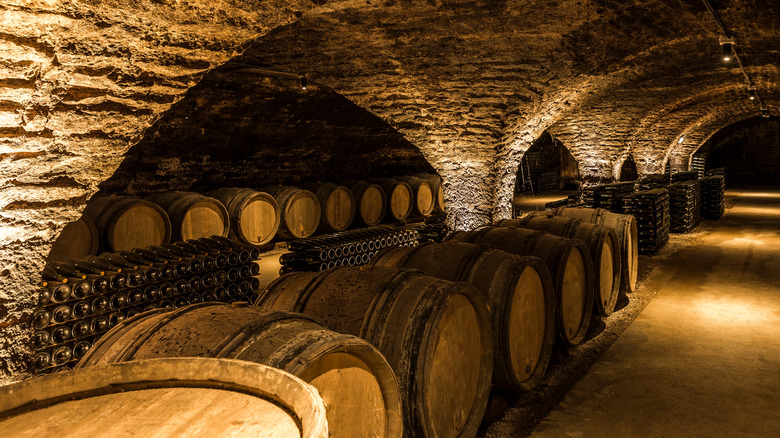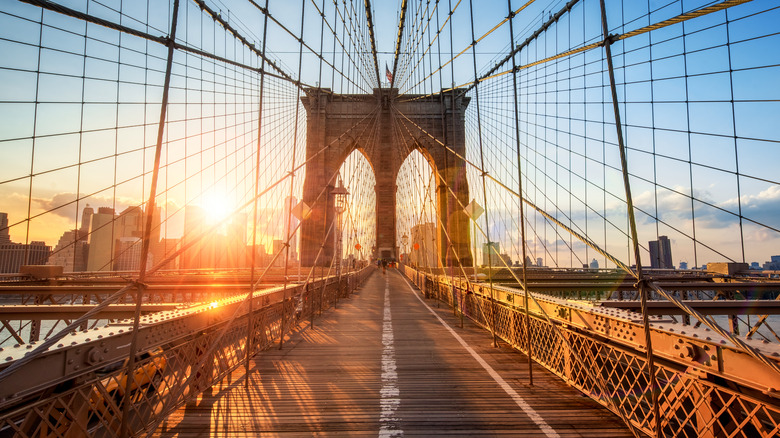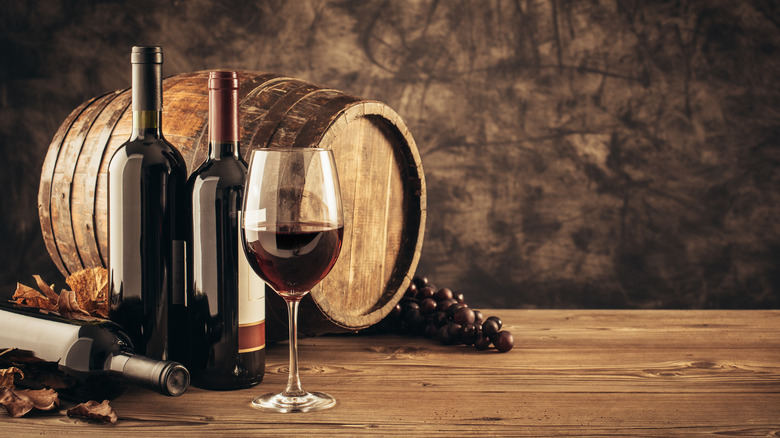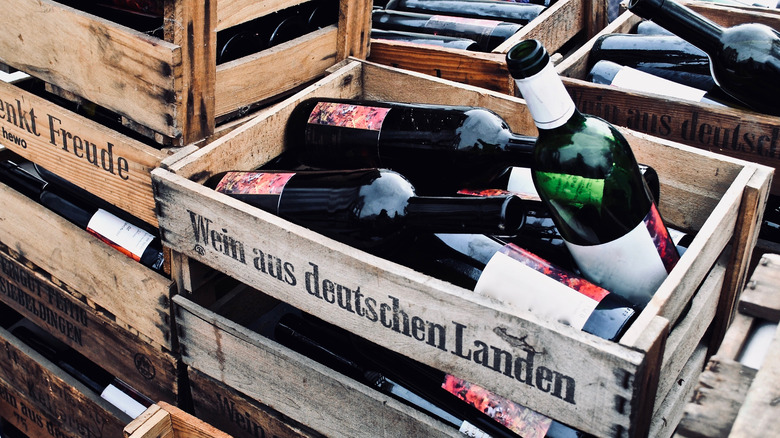The Reason There Were Once Hidden Wine Cellars Under The Brooklyn Bridge
Picture the scene: The long tunnel sloping down into the earth, cool in the heat of the summer, the granite walls clammy under the barrel vault. Racks and racks of Champagne, Bourgogne, and Mosel shimmer in the gloom. Each corridor has a French name: Avenue Des Chateux Haut Brion is one. Then a grand saloon full of tables and busy waiters, blue with cigar smoke. The walls are plastered here, rich with painted grapes and German proverbs in spiking fraktur. The band starts grinding out a waltz, and couples get up to dance. A stone Madonna watches from a niche.
Where are we? Some Weinstube in Koblenz? A vigneron's chateau in Alsace?
As NPR affirms, this is in fact Manhattan. To be precise, it's under the Brooklyn Bridge — directly under it. The year? Sometime between 1876 and the 1930s. These are the wine cellars of Anthony Oechs, a secret treasure in the capital of the world.
Inspired engineers
It was a mad place for a wine cellar. Wine cellars are temples of the past: to the unchanging cycle of the agricultural year, to the memory of good vintages. The Brooklyn Bridge was the opposite. It was a monument to technology and the frenetic pace of industrial New York. Built between 1869 and 1883, it was the world's first steel suspension bridge, a marvel of engineering. Today, about 116,000 vehicles cross it every day (per New York Simply).
The geniuses behind the bridge were the Roeblings, John and his son Washington. They first proposed a suspension bridge over the East River, and invented the steel wires by which the whole bridge hangs. The problem, of course, was funding. According to NPR, the estimated costs were around $15 million, which made the City of New York uneasy.
John Roebling had another brilliant idea. The anchorage of the bridge, on either side of the river, would require deep tunnels into the soft limestone and hard igneous rock that make up the islands of New York. If the City could develop and rent those tunnels, it could help offset the price of the bridge. And what better use for a cool, deep cavern than wine storage?
The end of prohibition saw the wine cellars' heyday
A succession of wine and liquor merchants rented the caverns on either side of the bridge before Anthony Oechs & Co. moved into the Manhattan side, per NPR. Prohibition had halted the (legal) operations in the wine cellars, but that ill-advised policy finally ended in 1933. Oechs bought the Manhattan-side cellars the next year.
This was probably the high point of the Brooklyn Bridge wine caverns, in terms of popularity and grandeur. Oechs himself had been a phenomenally successful merchant; his New York Times obituary, from 1905, notes that he left behind a million-dollar estate. He "gave largely" to the poor and was a pillar of New York's Roman Catholic and German immigrant communities.
World War II ended the fête. For reasons not publicly known, but possibly related to the war effort (or suspicions concerning German-Americans), the City of New York regained control of the caverns in 1942. They have been closed to the public ever since.
The German-American's winemaking legacy
German-Americans have played all the lead roles in this story, from the Roebling's suggestion of a wine cavern under the Brooklyn Bridge to the actual running of the caverns themselves. That's not by chance. German immigrants to the United States are historically the most underrated founders of America's thriving wine industry.
America's wine industry arguably started in the 1700s (the prototype of which began almost 200 years earlier), in the Spanish missions of California, per UC Davis. This wine, made from the red Mission grape (still grown in Spain as Listán Prieto, according to the Wine History Project) was consecrated for Catholic Mass or enjoyed locally, never exported. But, the wave of immigration following the Gold Rush brought huge numbers of Germans, many of them refugees from the political turmoil of 1848. Germans, especially from the Rhine and Mosel valleys, have a long and noble winemaking tradition. Many of the families who came to California saw the mild climate and well-drained soils of Northern California as a chance to carry it on. As Deutsche Welle explains, familiar names in California wine today — Krug and Beringer, for instance — laid the foundation for world-class appellations.
Elsewhere, German wine merchants left their mark, even on the names of grapes. "Zinfandel" is a German name first recorded in California; the grape had been known in southern Italy as Primitivo and Dalmatia as Crljenak, per Smithsonian.
Prost!



